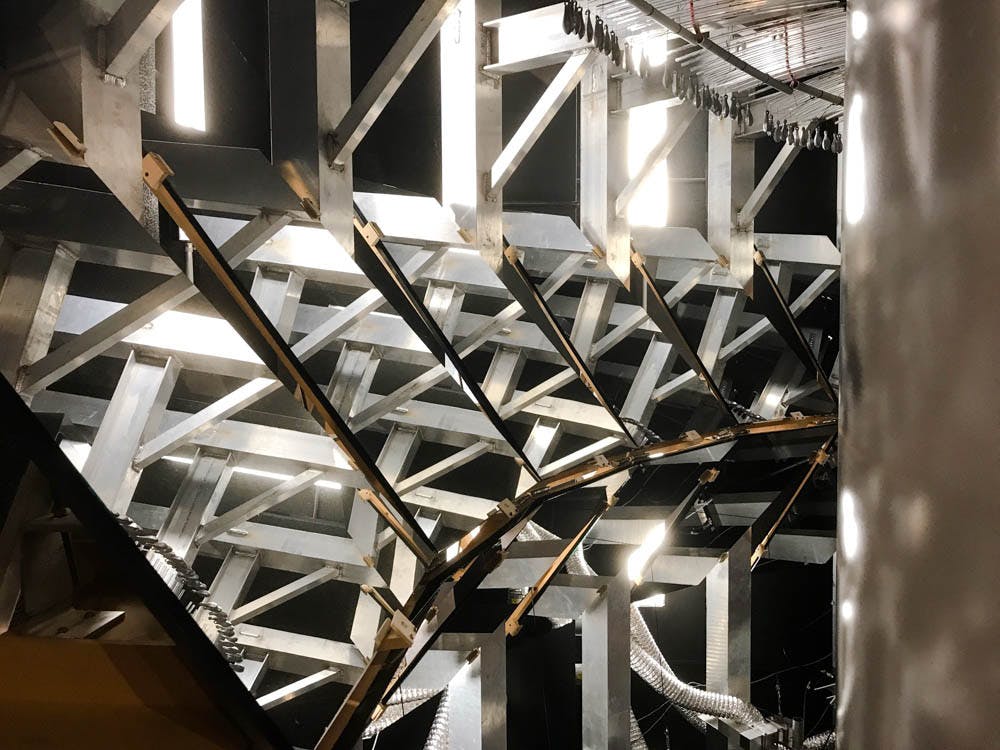University researchers can now walk on the surface of the moon, analyze the footprints of a dinosaur and study molecular structure — all in the same place, thanks to the YURT, the new virtual reality theater at the Center for Computation and Visualization.
The YURT is one of CCV’s two virtual reality systems. The second — the Cave Automatic Virtual Environment — is a cube-like structure that has seven projectors, two each on three of the sides and one on the bottom.
The YURT, built after the CAVE, was developed to be much larger and more advanced than its predecessor. “If seven projectors is cool, then 70 projectors would be 10 times as cool,” said Tom Sgouros, manager of the Virtual Reality Lab, in describing the thought process behind the YURT’s inception. The YURT is comprised of 145 mirrors that reflect transmissions from the 69 projectors that surround it. It uses 20 computers and 1.3 miles of video cable. The 2 million dollar-machine was funded by a grant from the National Science Foundation, Sgouros said.
To experience the virtual reality, the user dons a headpiece equipped with motion-capture technology and walks into the center of the YURT, which is enclosed by screens. Motion capture sensors inside read the placement of the user, which in turn allows the system to adjust the roughly 100 million-pixel projections on the screens to the user’s position.
This highly advanced virtual reality system opens up many new possibilities in the field of research, Sgouros said. For example, the YURT can project the surface of Mars. Where before scientists could look at contour maps to deductively discover where there were cliffs on the Martian surface, they can now use virtual reality to see it in a much more intuitive and accessible way, Sgouros said. Canyons that are believed to have been shaped by water can also be studied in this way, he noted. Using this virtual reality medium of analysis, the question “Is there water?” is replaced with “Where is the water?” according to Sgouros.
The work conducted by paleontologist Stephen Gatesy concerning analysis of dinosaur footprints also stands to benefit from this technology. The fluid-dynamic model of mud that the YURT can display will allow for a better view and therefore understanding of how dinosaurs walked, Sgouros said.
The YURT will also create a more intuitive presentation of exploratory data analysis in medicine, he added.
There are a number of students working on projects with researchers using the YURT, Sgouros noted. Active projects include a medical study and the creation of a program that allows users to build their own robots. Researchers are also taking advantage of the YURT’s unique ability to visualize phenomena ranging from star births and supernovas to four-dimensional objects.
Virtual reality can also help to make students more engaged with learning, said Adam Blumenthal, a virtual reality artist-in-residence who produces interactive media. Using the technology at the Granoff Center for the Creative Arts, he worked on a for-the-classroom recreation of the Gaspee Affair, a 17th century event in Narragansett Bay that is often considered the first act of war by colonists in the events leading to the Revolutionary War.
Virtual reality technology has advanced greatly since Blumenthal was first introduced to it in 1990. He experienced it initially as it was emerging from military labs at NASA and was “blown away by the potential.” It was too early at the time for virtual reality to be used outside of these developmental settings, so he had to wait while it “incubated” until it was usable in places such as the CCV.
The main benefit of these large-scale virtual reality systems as compared to headset systems — like the HTC Vive and the Oculus Rift — is the collaboration they foster, said Sam Fulcomer, associate director of systems at the CCV. The success of CCV technology is central to the future of high-performance computing at the University, he said, adding that in the future, scientific visualization using virtual reality could receive unified and widespread support considering the abilities of display technology. It could also see wider use in laboratory settings, particularly due to the increased usage of head-mounting displays, Fulcomer added.





